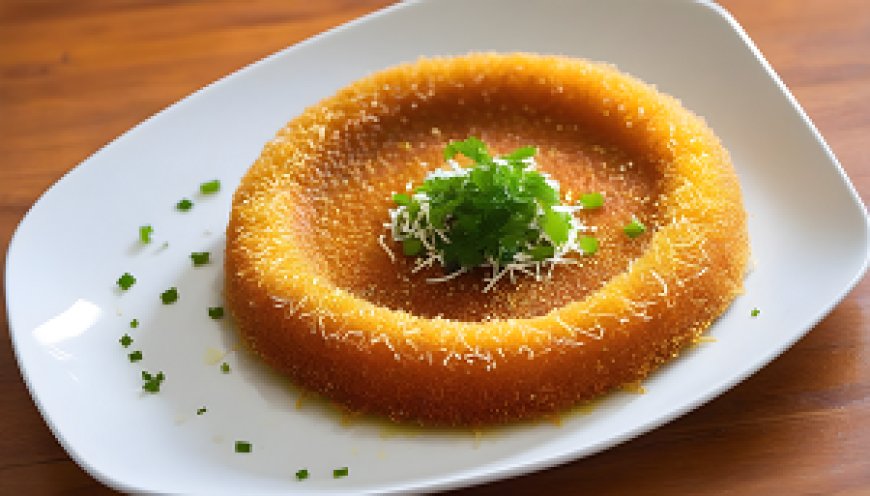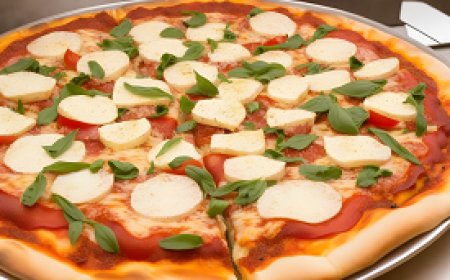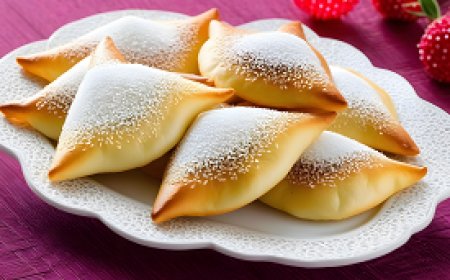The secret to achieving crispy kanafeh from the first attempt
If you're wondering about the secret to achieving crispy kanafeh from the first attempt, the art lies in achieving a precise balance between ingredients and techniques. It starts with meticulously preparing the dough, where the careful proportion of water and oils is crucial to achieving a unique texture that enhances crispiness and a light consistency. Additionally, it involves the technique of layering and spreading the dough thinly, allowing heat to distribute evenly and achieve perfect browning. In essence, the secret lies in mastering the details of the process and paying meticulous attention, resulting in a deliciously crispy kanafeh that exceeds expectations from the very first step.

In the world of culinary arts, enthusiasts and professionals alike strive for perfection in creating delectable desserts, and among those that hold a special place in the hearts of many is the crispy kanafeh. The secret to achieving crispy kanafeh from the first attempt lies in the art and science of mixing and baking. Determining ingredient proportions and applying specific techniques are crucial components of this delightful secret. In this context, we will explore how to achieve the delicious and crispy kanafeh through the intricate details of ingredient composition and precise preparation steps. Let's together delve into the realm of flavors and skills that make kanafeh an unforgettable experience with every bite.
Ingredient Balance
Creating the perfect crispy kanafeh involves a delicate balance of ingredients to achieve the desired flavor and texture. Carefully choosing and measuring each component is crucial for a successful outcome. Here's a detailed guide on how to achieve the ideal ingredient balance for crispy kanafeh:
1. Choosing the Right Kanafeh Dough:
- Start with high-quality kanafeh dough or kadaif, which is essential for achieving the desired crispiness. Fresh and fine strands of dough contribute to a light and flaky texture. If using pre-packaged dough, ensure it is fresh and not overly dry.
2. Buttering the Dough Layers:
- Butter is a key component for both flavor and crispiness. Use clarified butter (ghee) or melted unsalted butter to brush each layer of kanafeh dough. Ensure an even distribution to create crispiness throughout the dessert.
3. Sugar Syrup Consistency:
- Prepare a sugar syrup with the right consistency. The syrup adds sweetness and moisture to the kanafeh, preventing it from becoming too dry. Aim for a thick and slightly sticky syrup. Infuse it with flavors like orange blossom or rose water for an authentic touch.
4. Balancing Sweetness:
- Achieving the perfect sweetness is crucial. Balance the sweetness of the sugar syrup with the sweetness of the kanafeh filling. If the syrup is too sweet, the overall dessert may become overpowering.
5. Filling Choices:
- Choose a flavorful filling for your kanafeh. Traditional fillings include a mixture of akkawi or mozzarella cheese with semolina, or a combination of nuts such as pistachios or almonds. The filling should contribute to the overall taste without overwhelming the dish.
6. Spices and Aromatics:
- Enhance the flavor profile with a touch of spice. A pinch of cinnamon or a sprinkle of ground cloves can add depth to the kanafeh. Use these spices sparingly to complement, not dominate, the overall taste.
7. Nuts for Texture:
- Nuts play a dual role in adding texture and flavor. Choose fresh and high-quality nuts, and consider toasting them for an extra layer of crunchiness. Distribute them evenly to ensure a satisfying bite in every serving.
8. Proper Layering Technique:
- Pay attention to the layering technique. Spread the buttered dough evenly in the pan, ensuring each layer is well-coated. This promotes even crispiness and a uniform texture.
9. Baking Temperature and Time:
- Bake the kanafeh at the right temperature and for the appropriate duration. A moderate oven temperature allows the layers to crisp up without burning. Keep an eye on the color, and adjust the baking time if needed.
10. Resting Period:
- Allow the kanafeh to rest after baking. This gives the syrup time to penetrate the layers, ensuring a moist interior while maintaining the desired crispiness on the outside.
11. Presentation and Garnishes:
- Present the kanafeh beautifully and consider garnishes like a sprinkle of finely chopped pistachios or a dusting of powdered sugar. These finishing touches add visual appeal and a touch of extra flavor.
12. Serving Fresh:
- Crispy kanafeh is best enjoyed fresh. Serve it warm, allowing the layers to retain their crispiness and the filling to be gooey and flavorful.
Creating the perfect crispy kanafeh is an art that involves precision in ingredient selection and measurement. By carefully balancing the sweetness, choosing high-quality ingredients, and paying attention to the baking process, you can achieve a kanafeh that delights the senses with its crispy layers, flavorful filling, and perfect sweetness.
How to make healthy Nabulsi kunafa
Making a healthy version of Nabulsi kunafa involves incorporating nutritious ingredients and making mindful choices to reduce the overall calorie and sugar content. Here's a detailed guide on how to make a healthier Nabulsi kunafa:
Ingredients
-
Whole Wheat or Multigrain Kadaif (Kunafa) Dough:
- Choose whole wheat or multigrain kadaif dough instead of the traditional refined flour variety. This adds more fiber and nutrients to the dessert.
-
Olive Oil or Nut Butter:
- Replace traditional clarified butter (ghee) with a healthier option like extra virgin olive oil or a natural nut butter. These alternatives provide healthier fats.
-
Natural Sweeteners:
- Opt for natural sweeteners like honey, maple syrup, or agave nectar instead of using large amounts of refined sugar. These alternatives add sweetness with additional nutrients.
-
Low-Fat Cheese:
- Choose a low-fat or part-skim cheese for the filling. Nabulsi cheese is the traditional choice, but you can explore alternatives like ricotta or cottage cheese for a lighter option.
-
Nuts and Seeds:
- Include a variety of nuts and seeds for added texture and nutrition. Almonds, walnuts, or flaxseeds can be excellent choices. Toast them lightly for extra flavor.
-
Spices for Flavor:
- Use spices like cinnamon, cardamom, or nutmeg to enhance the flavor without relying heavily on sugar. These spices bring warmth and depth to the kunafa.
-
Greek Yogurt Topping:
- Instead of heavy creams or sweetened toppings, consider a dollop of Greek yogurt for a creamy and protein-rich addition. You can sweeten it naturally with a drizzle of honey.
-
Fresh Fruit Garnish:
- Garnish the kunafa with fresh fruits like berries, sliced kiwi, or pomegranate seeds. This not only adds natural sweetness but also provides additional vitamins and antioxidants.
Preparation Steps
-
Prepare the Kadaif Dough:
- If possible, choose a whole wheat or multigrain kadaif dough. Follow the package instructions for soaking and separating the strands.
-
Choose a Healthy Fat:
- Use a healthier fat like extra virgin olive oil or a natural nut butter to brush the layers of kadaif. Brush lightly to ensure a crisp texture without excess oil.
-
Sweeten Mindfully:
- When preparing the sugar syrup, opt for natural sweeteners like honey or maple syrup. Use them sparingly, adjusting to your preferred level of sweetness.
-
Select a Light Cheese Filling:
- Choose a low-fat or part-skim cheese for the filling. Grate or crumble it evenly over the layers of kadaif.
-
Incorporate Nuts and Seeds:
- Add a mix of nuts and seeds to the cheese filling for crunch and nutritional value. Toast them lightly before incorporating into the kunafa.
-
Spice it Up:
- Use spices like cinnamon, cardamom, or nutmeg in moderation to infuse flavor without relying on excessive sugar.
-
Bake to Perfection:
- Bake the kunafa at a moderate temperature until golden brown. Keep an eye on the color and adjust the baking time as needed.
-
Greek Yogurt Topping:
- Serve the kunafa with a dollop of plain Greek yogurt. You can lightly sweeten the yogurt with honey for a healthier alternative to traditional toppings.
-
Fresh Fruit Finishing Touch:
- Garnish the kunafa with fresh fruits just before serving. The natural sweetness and vibrant colors enhance both the flavor and presentation.
Final Tips
-
Portion Control:
- Practice portion control to enjoy the kunafa without overindulging. A smaller serving can still satisfy your sweet tooth.
-
Serve Fresh:
- Nabulsi kunafa is best enjoyed fresh. Serve it soon after preparation to maintain its crispiness.
-
Experiment with Fillings:
- Feel free to experiment with alternative fillings, such as incorporating more nuts, seeds, or dried fruits for added nutritional value.
-
Share and Enjoy:
- Share your healthier Nabulsi kunafa with family and friends, promoting mindful enjoyment of this delicious dessert.
By making thoughtful ingredient choices and incorporating healthier alternatives, you can create a version of Nabulsi kunafa that not only satisfies your sweet cravings but also aligns with your health-conscious lifestyle.
Layering Technique
The layering technique in cooking, especially when working with dough, is crucial to achieving the desired texture, flavor, and appearance of the final dish. This holds true for various dishes, including pastries, lasagna, and, in this case, kunafa. Let's delve into the importance of evenly and thinly layering the dough, focusing on achieving perfect browning and effective heat distribution.
Importance of Layering Technique in Kunafa:
-
Even Browning:
- Thin and even layers of dough ensure that each layer gets exposed to the heat uniformly during baking. This results in consistent browning, giving the kunafa an appealing golden color. Uneven layers may lead to some parts being undercooked or overly browned.
-
Crisp Texture:
- Thin layers contribute to the crispiness of the final product. Proper layering allows the heat to penetrate each layer, evaporating excess moisture and creating a delicate, crunchy texture. Thick layers can hinder this process, resulting in a less crispy outcome.
-
Effective Heat Distribution:
- Thin layers of dough facilitate efficient heat distribution. As the kunafa bakes, the heat can easily reach and cook each layer, ensuring that the entire dish cooks evenly. This prevents the risk of having raw or doughy portions in the middle of the kunafa.
-
Balanced Filling Integration:
- Even layers provide a balanced integration of the filling throughout the kunafa. Whether it's a cheese filling, nut mixture, or any other ingredient, proper layering allows for an even distribution of flavors. This ensures that each bite contains a harmonious combination of crispy dough and flavorful filling.
-
Avoiding Sogginess:
- Thin layers help prevent sogginess. When the layers are too thick, the moisture from the filling may not evaporate adequately, leading to a soggy or undercooked interior. Thin layers allow for better moisture evaporation, maintaining the desired crispness.
Layering Technique Tips:
-
Separate and Fluff the Strands:
- Before layering, ensure that the strands of dough are separated and fluffed. This prevents clumping and helps achieve an even distribution of dough in the pan.
-
Brush Each Layer Lightly:
- Use a light touch when brushing each layer with butter or oil. This ensures that the layers are coated evenly, promoting consistent browning and preventing excess greasiness.
-
Evenly Spread and Pat Down:
- Spread each layer of dough evenly in the pan, patting it down gently. This helps create a uniform thickness and allows for better heat transfer during baking.
-
Consistent Filling Distribution:
- If the kunafa includes layers of filling, such as nuts or cheese, distribute them evenly across each layer. This contributes to a balanced taste and texture in every bite.
-
Pay Attention to Edges:
- Ensure that the layers reach the edges of the pan. Even layers extending to the edges contribute to an attractive appearance and prevent uneven cooking at the periphery.
-
Adjust Thickness as Needed:
- Depending on the recipe and desired outcome, adjust the thickness of the layers accordingly. Thinner layers generally result in a crispier texture.
-
Practice Patience:
- Layering can be time-consuming, but practicing patience is essential. Take the time to layer each strand with care, and the results will reflect the effort.
The layering technique plays a pivotal role in the success of kunafa and other layered dishes. By paying attention to the thickness, evenness, and proper distribution of layers, you can achieve a kunafa that is not only visually appealing but also boasts a delightful combination of crispy texture and well-integrated flavors. Whether you're a seasoned baker or trying your hand at layering for the first time, mastering this technique enhances the overall quality of your culinary creations.
Meticulous Care
Meticulous care in preparing kanafeh involves a commitment to details and a thorough, careful approach to each step of the process. Achieving the best results from the first attempt requires attention to ingredients, techniques, and the overall cooking process. Let's explore the importance of meticulous care in making kanafeh:
1. Ingredient Selection:
- Quality Matters: Choosing high-quality ingredients is the foundation of a successful kanafeh. From the type of phyllo dough to the freshness of nuts and the quality of cheese, each ingredient contributes to the final flavor and texture.
2. Precise Measurement:
- Balancing Act: Meticulous care involves precise measurements of ingredients. Balancing the sweetness, richness, and textures is crucial. This ensures that the kanafeh is neither too sweet nor lacking in flavor.
3. Preparing the Dough:
- Fluffing and Separating: Taking the time to fluff and separate the strands of the phyllo dough ensures even layering. This meticulous step contributes to the overall texture of the kanafeh, preventing clumps and ensuring proper baking.
4. Layering Technique:
- Even and Thin Layers: As mentioned earlier, meticulous care involves an even and thin layering technique. Each layer should be delicately brushed with butter or oil, contributing to consistent browning and a crisp texture.
5. Filling Distribution:
- Uniform Spread: When incorporating fillings such as nuts or cheese, meticulous care ensures a uniform spread across each layer. This attention to detail guarantees that every bite contains a harmonious blend of flavors.
6. Baking Precision:
- Monitoring Heat: Paying close attention to the baking process is crucial. Meticulous care involves monitoring the heat, ensuring the kanafeh cooks evenly, and achieving the desired level of golden brown without burning.
7. Timing Consideration:
- Avoiding Undercooking or Overcooking: Timing is everything in baking, and meticulous care involves avoiding undercooking or overcooking the kanafeh. This ensures a perfect balance of crispiness and tenderness.
8. Presentation Details:
- Aesthetic Touch: Meticulous care extends to the presentation. Whether it's garnishing with pistachios, drizzling with sugar syrup, or adding a sprinkle of rose water, these details enhance the visual appeal and overall experience.
9. Taste Testing:
- Refining Flavors: Meticulous care includes taste testing throughout the process. Adjustments to sweetness, the balance of flavors, or the crispiness of the layers can be made to refine the final product.
10. Continuous Learning:
- Adaptation and Improvement: Meticulous care involves a mindset of continuous learning and improvement. Evaluating each attempt, seeking feedback, and adapting the recipe or techniques contribute to mastering the art of making kanafeh.
Meticulous care in making kanafeh is not just about following a recipe; it's an art that involves passion, attention to detail, and a commitment to excellence. From the selection of ingredients to the final presentation, every step is an opportunity to enhance the overall quality of this beloved dessert. With each meticulous effort, the goal is not only to achieve a delicious kanafeh but to create a culinary masterpiece that delights the senses and brings joy to those who savor it.
Healthy tips when preparing healthy kunafa
- When purchasing kanafeh dough or making it at home, ensure that it is made from healthy ingredients. For example, choose dough made from whole wheat flour instead of white flour, or at least replace half of the white flour with whole wheat flour, as it contains higher levels of fiber and nutrients.
- Using a small amount of butter, as mentioned in the ingredients, helps reduce the saturated fat content in the recipe while maintaining its flavor and texture.
- It is preferable to choose Akkawi cheese instead of mozzarella because Akkawi cheese has lower amounts of saturated fat and has a taste and texture closer to the original kanafeh.
- It is not necessary to strictly adhere to the quantity of cheese mentioned in the recipe. You can control the amount of cheese moderately and increase other healthy ingredients such as nuts, which contain healthy unsaturated fats and protein.
In conclusion
the secret to achieving crispy kanafeh from the first attempt emerges as an artistic finesse and refined taste that requires a meticulous blend of elements and mastery of the process. It is an exquisite balance between artistic sensibility and scientific expertise, where fresh ingredients meet skilled baking techniques to create an unparalleled sensory experience. It is not just a dessert but a traditional art passed down from generation to generation. Achieving crispy kanafeh from the first attempt unveils dedication and passion for details, making it an unforgettable moment in the world of exquisite flavors.
Sources
-
Basmaty
-
Allrecipes
-
Shahiya
-
Wassfatt
What's Your Reaction?




































































































































































